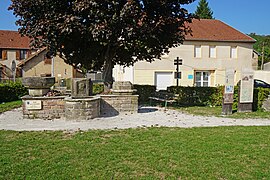| Saulnot | |
 | |
| The town hall | |
| Information | |
| Country | |
|---|---|
| Area | 26,73 km² |
| Population | 762 hab. () |
| Density | 28,51 inhab./km² |
| Postal code | 70400 |
| Spindle | UTC 01:00, UTC 02:00 |
| Location | |
 47 ° 33 ′ 45 ″ N 6 ° 38 ′ 0 ″ E | |
| Official site | |
Saulnot is a municipality and a village of Haute-Saone. It owes its development to the exploitation of salt for nearly a millennium. The village is dominated by a church in red sandstone from the Vosges surmounted by a Comtois bell tower in glazed red tiles.
Understand
Story
Salt is mined between the XIIe century and 1826 for the benefit of the principality of Montbeliard. In 1589, coal was discovered in Corcelles and the exploitation was initiated by Heinrich Schickhardt in order to reduce the consumption of wood from the saltworks, the exploitation will be done intermittently until 1922, in particular in the last period to supply the saltworks. of Gouhenans.
The town also has mines located in the communal forest exploiting iron ore for the blast furnaces in the area.

A coal-fired saline oven.

Surface infrastructure of a coal pit circa 1910.
To go
Circulate
To see
Heritage of the village
- 1 Church of the Décollation-de-Saint-Jean-Baptiste
 free. – located on a rocky elevation and entirely built with pink sandstone from the Vosges. The building is also characterized by its Comtois bell tower covered with red glazed tiles.
free. – located on a rocky elevation and entirely built with pink sandstone from the Vosges. The building is also characterized by its Comtois bell tower covered with red glazed tiles. - 2 Old wash house – built with the same materials as the church.
- 3 Commune house – surmounted by a steeple with clock.
- 4 Memorial – surmounted by a statue.
- 5 Square Heinrich Schickhardt – ruin of a fountain and explanatory panels.

The village church.

The old wash house.

The common house.
The war memorial.

Square Heinrich Schickhardt evoking the saltworks.
Mining heritage and natural sites
- 6 Saulnot Marsh – protected natural space serving as stages for several species of migratory birds.
- 7 Baume cave in Gonvillard – visits are regularly organized by speleologists.
- 8 Old mine shaft in Corcelles Cotelle path – served as a ventilation shaft for coal mines in the 1910s.

The Saulnot marshes.

The entrance to the Baume cave.
The old open mine shaft.
Do
To buy
Eat
Have a drink / Go out
Housing
Communicate
Manage the day-to-day
Around
- 1 Granges-le-Bourg – village dominated by a ruined castle with three historical monuments
 .
. - Saulnot
- Melecey
- Gouhenans
- Villersexel
- Hericourt
- lure
- Ronchamp










